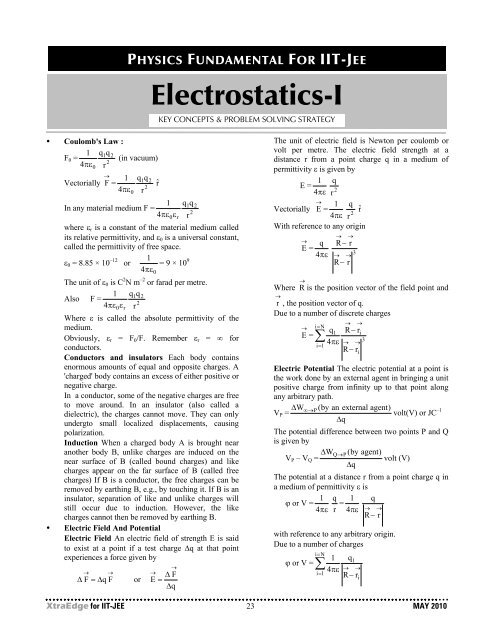Create successful ePaper yourself
Turn your PDF publications into a flip-book with our unique Google optimized e-Paper software.
PHYSICS FUNDAMENTAL FOR <strong>IIT</strong>-<strong>JEE</strong><br />
Electrostatics-I<br />
KEY CONCEPTS & PROBLEM SOLVING STRATEGY<br />
• Coulomb's Law :<br />
1 q1q<br />
2<br />
F 0 =<br />
(in vacuum)<br />
2<br />
4πε0 r<br />
Vectorially → 1 q1q<br />
2<br />
F= rˆ<br />
2<br />
4πε<br />
0 r<br />
1 q1q<br />
2<br />
In any material medium F =<br />
2<br />
4πε0εr<br />
r<br />
where ε r is a constant of the material medium called<br />
its relative permittivity, and ε 0 is a universal constant,<br />
called the permittivity of free space.<br />
ε 0 = 8.85 × 10 –12 1<br />
or<br />
4πε = 9 × 109<br />
0<br />
The unit of ε 0 is C 2 N m –2 or farad per metre.<br />
1 q1q<br />
2<br />
Also F =<br />
2<br />
4πε0εr<br />
r<br />
Where ε is called the absolute permittivity of the<br />
medium.<br />
Obviously, ε r = F 0 /F. Remember ε r = ∞ for<br />
conductors.<br />
Conductors and insulators Each body contains<br />
enormous amounts of equal and opposite charges. A<br />
'charged' body contains an excess of either positive or<br />
negative charge.<br />
In a conductor, some of the negative charges are free<br />
to move around. In an insulator (also called a<br />
dielectric), the charges cannot move. They can only<br />
undergto small localized displacements, causing<br />
polarization.<br />
Induction When a charged body A is brought near<br />
another body B, unlike charges are induced on the<br />
near surface of B (called bound charges) and like<br />
charges appear on the far surface of B (called free<br />
charges) If B is a conductor, the free charges can be<br />
removed by earthing B, e.g., by touching it. If B is an<br />
insulator, separation of like and unlike charges will<br />
still occur due to induction. However, the like<br />
charges cannot then be removed by earthing B.<br />
• Electric Field And Potential<br />
Electric Field An electric field of strength E is said<br />
to exist at a point if a test charge ∆q at that point<br />
experiences a force given by<br />
→<br />
→ →<br />
→<br />
∆ F<br />
∆ F = ∆q<br />
F or E =<br />
∆q<br />
The unit of electric field is Newton per coulomb or<br />
volt per metre. The electric field strength at a<br />
distance r from a point charge q in a medium of<br />
permittivity ε is given by<br />
E =<br />
1<br />
4πε<br />
q<br />
2<br />
r<br />
Vectorially → 1 q<br />
E = 4πε<br />
2 rˆ<br />
r<br />
With reference to any origin<br />
→<br />
E =<br />
q<br />
4πε<br />
→<br />
R−<br />
r<br />
→<br />
→<br />
3<br />
→<br />
R−<br />
r<br />
Where R → is the position vector of the field point and<br />
→<br />
r , the position vector of q.<br />
Due to a number of discrete charges<br />
i=<br />
N<br />
→<br />
→<br />
→<br />
q E =<br />
1 R−<br />
ri<br />
∑<br />
3<br />
4πε<br />
→ →<br />
i=<br />
1<br />
R−<br />
r<br />
i<br />
Electric Potential The electric potential at a point is<br />
the work done by an external agent in bringing a unit<br />
positive charge from infinity up to that point along<br />
any arbitrary path.<br />
∆W∞→<br />
(by an external agent)<br />
V P = P<br />
volt(V) or JC –1<br />
∆q<br />
The potential difference between two points P and Q<br />
is given by<br />
∆W Q → P (by agent)<br />
V P – V Q =<br />
volt (V)<br />
∆q<br />
The potential at a distance r from a point charge q in<br />
a medium of permittivity ε is<br />
ϕ or V =<br />
1<br />
4πε<br />
q 1 =<br />
r 4πε<br />
q<br />
→ →<br />
R− r<br />
with reference to any arbitrary origin.<br />
Due to a number of charges<br />
i=<br />
N<br />
1 q1<br />
ϕ or V = ∑<br />
4πε<br />
→ →<br />
i= 1 R−<br />
r<br />
i<br />
XtraEdge for <strong>IIT</strong>-<strong>JEE</strong> 23 MAY 2010

















